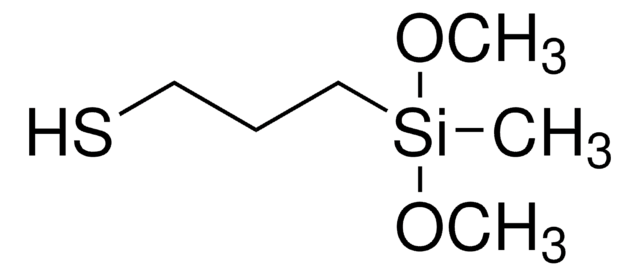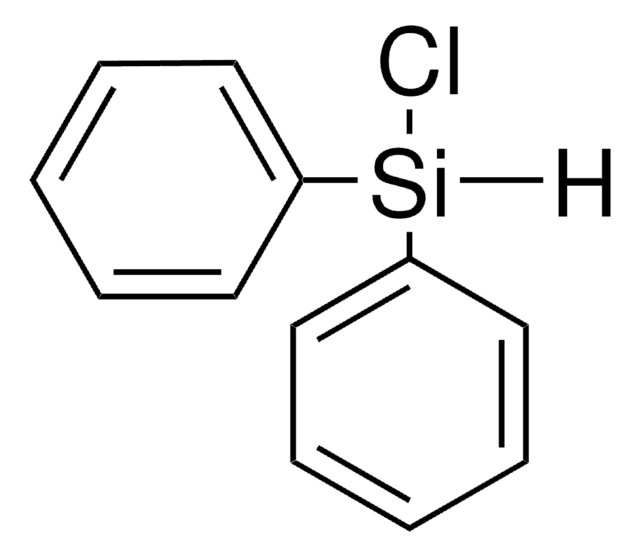All Photos(2)
About This Item
Linear Formula:
(C6H5)2Si(OH)2
CAS Number:
Molecular Weight:
216.31
Beilstein:
2523445
EC Number:
MDL number:
UNSPSC Code:
12352103
PubChem Substance ID:
NACRES:
NA.23
Recommended Products
vapor density
>1 (vs air)
Assay
95%
form
powder
SMILES string
O[Si](O)(c1ccccc1)c2ccccc2
InChI
1S/C12H12O2Si/c13-15(14,11-7-3-1-4-8-11)12-9-5-2-6-10-12/h1-10,13-14H
InChI key
OLLFKUHHDPMQFR-UHFFFAOYSA-N
Looking for similar products? Visit Product Comparison Guide
General description
Diphenylsilanediol(DPSD) is an alkoxysilane that is used as a silane based precusor in the synthesis of organosiloxane based resins.
Application
DPSD may be used as a precursor in the synthesis of linear vinyl oligosiloxane resins which can be potentially used in the fabrication of thermally resistant light emitting diode(LED) encapsulant. Mercaptopropyl-phenyl-oligosiloxane and phenyl-vinyl-oligosiloxane may be synthesized by using DPSD which can further be used as a thiolene derived dielectric layer for organic thin film transistors.
Signal Word
Danger
Hazard Statements
Precautionary Statements
Hazard Classifications
Flam. Sol. 1
Storage Class Code
4.1B - Flammable solid hazardous materials
WGK
WGK 1
Flash Point(F)
127.4 °F - closed cup
Flash Point(C)
53 °C - closed cup
Personal Protective Equipment
dust mask type N95 (US), Eyeshields, Gloves
Certificates of Analysis (COA)
Search for Certificates of Analysis (COA) by entering the products Lot/Batch Number. Lot and Batch Numbers can be found on a product’s label following the words ‘Lot’ or ‘Batch’.
Already Own This Product?
Find documentation for the products that you have recently purchased in the Document Library.
Customers Also Viewed
Thiol-Ene Reaction Derived Sol-Gel Hybrid Dielectric Layer for Oragnic Thin Film Transistors.
Kim J, et al.
ECS Transactions, 50(4), 83-88 (2013)
High color rendering white light-emitting diodes based on a green silicate phosphor mixed with a red dye-bridged hybrid.
Kwak S, et al.
Royal Society of Chemistry Advances, 2(32), 12371-12377 (2012)
Hyeon-Gyun Im et al.
ACS applied materials & interfaces, 12(50), 56462-56469 (2020-12-02)
Metal nanowires (NWs) are promising transparent conducting electrode (TCE) materials because of their excellent optoelectrical performance, intrinsic mechanical flexibility, and large-scale processability. However, the surface roughness, thermal/chemical instability, and limited electrical conductivity associated with empty spaces between metal NWs are
J G Cunningham et al.
American journal of veterinary research, 42(12), 2178-2181 (1981-12-01)
A controlled clinical trial of the anti-epileptic efficacy and toxic side effects of diphenylsilanediol was conducted on 24 client-owned epileptic dogs. Data obtained from an abbreviated procedural treatment program indicated that diphenylsilanediol compared favorably with primidone as an anti-epileptic compound
Junho Jang et al.
Nanoscale, 11(31), 14887-14895 (2019-07-31)
Herein, we report a luminescent light-emitting diode (LED) encapsulating material using a thermally curable quantum dot (QD)/siloxane hybrid (TSE-QD) color converter, which has superior long-term stability even at elevated temperatures, in high humidity, and in various chemicals. The TSE-QD is
Our team of scientists has experience in all areas of research including Life Science, Material Science, Chemical Synthesis, Chromatography, Analytical and many others.
Contact Technical Service









